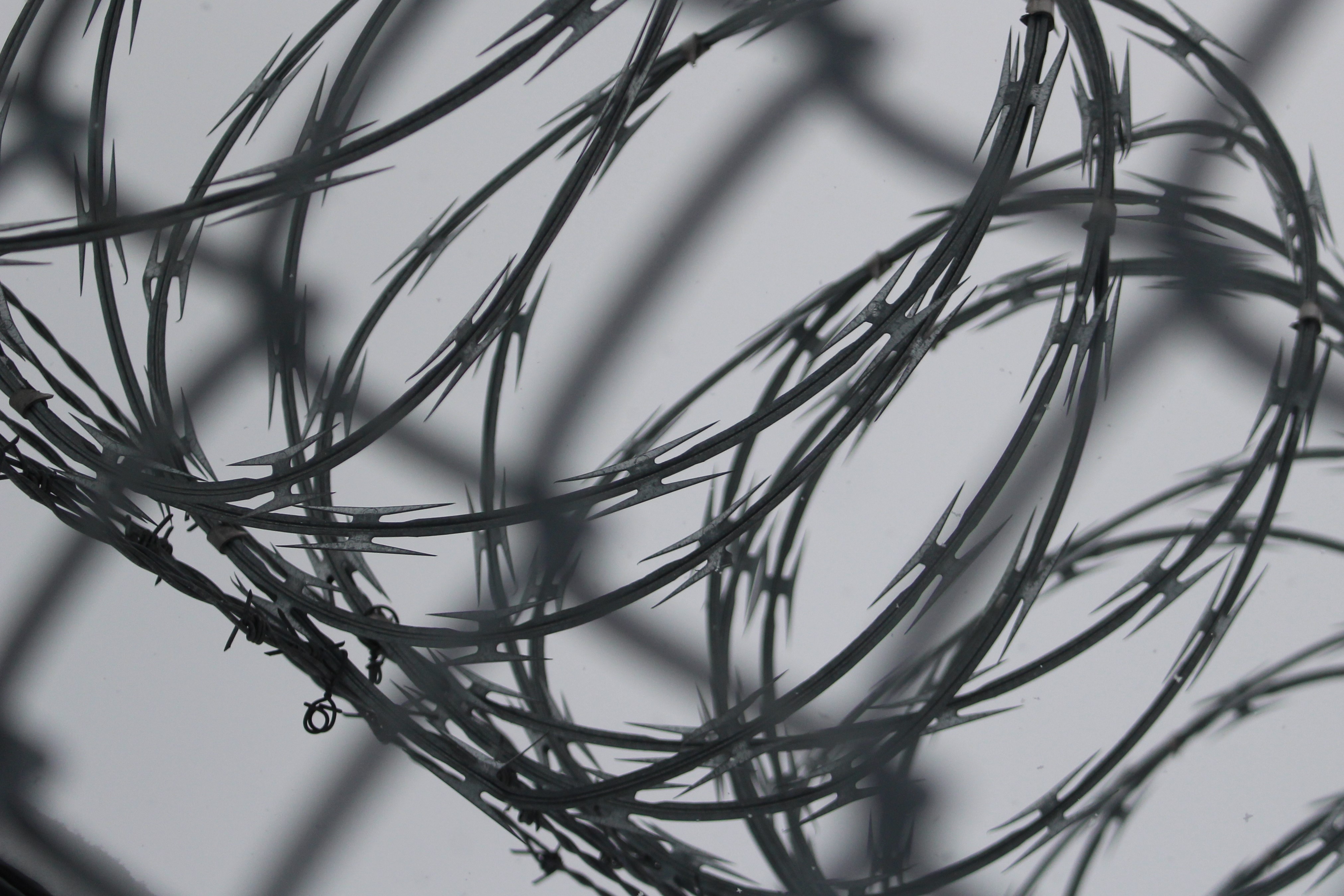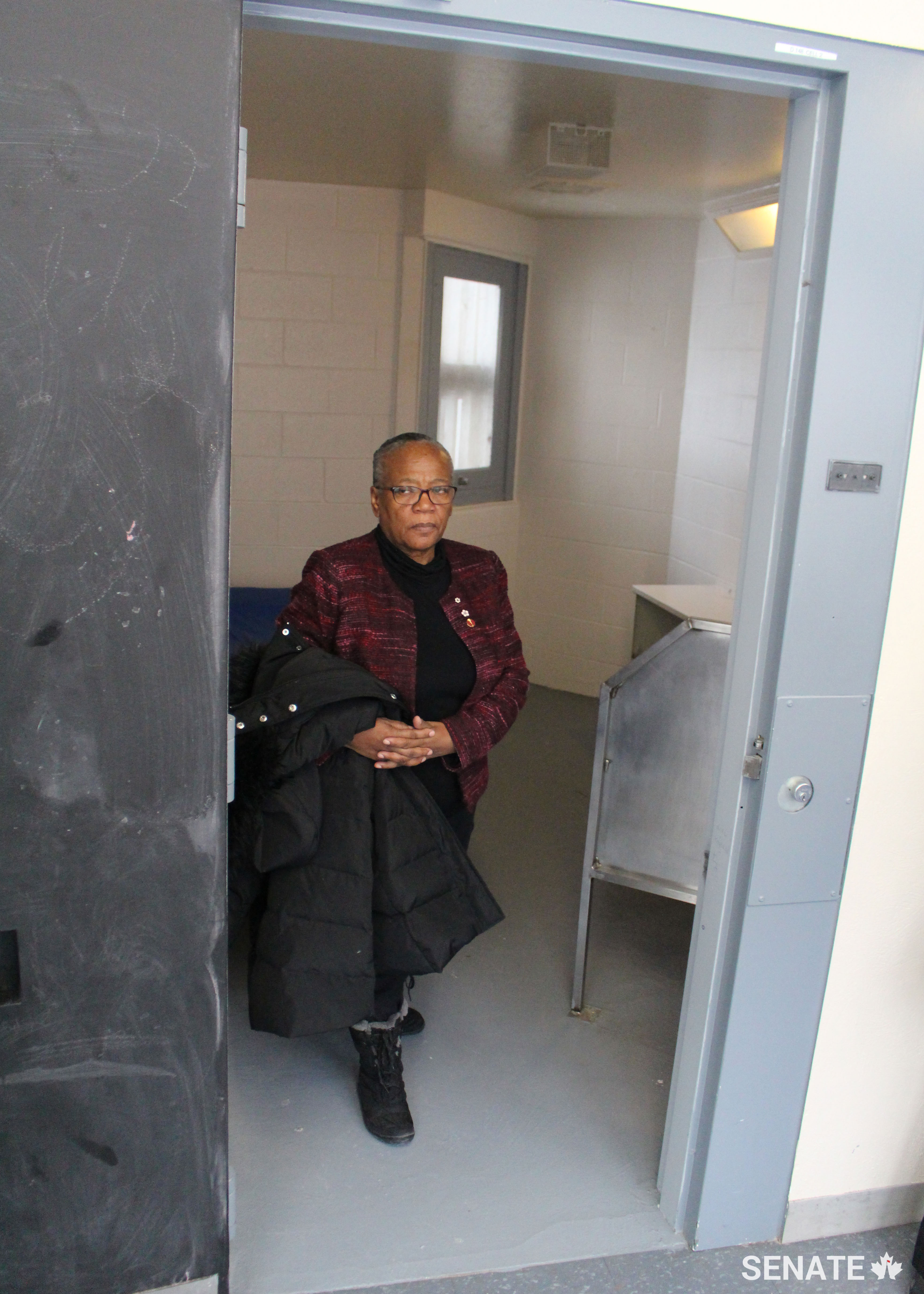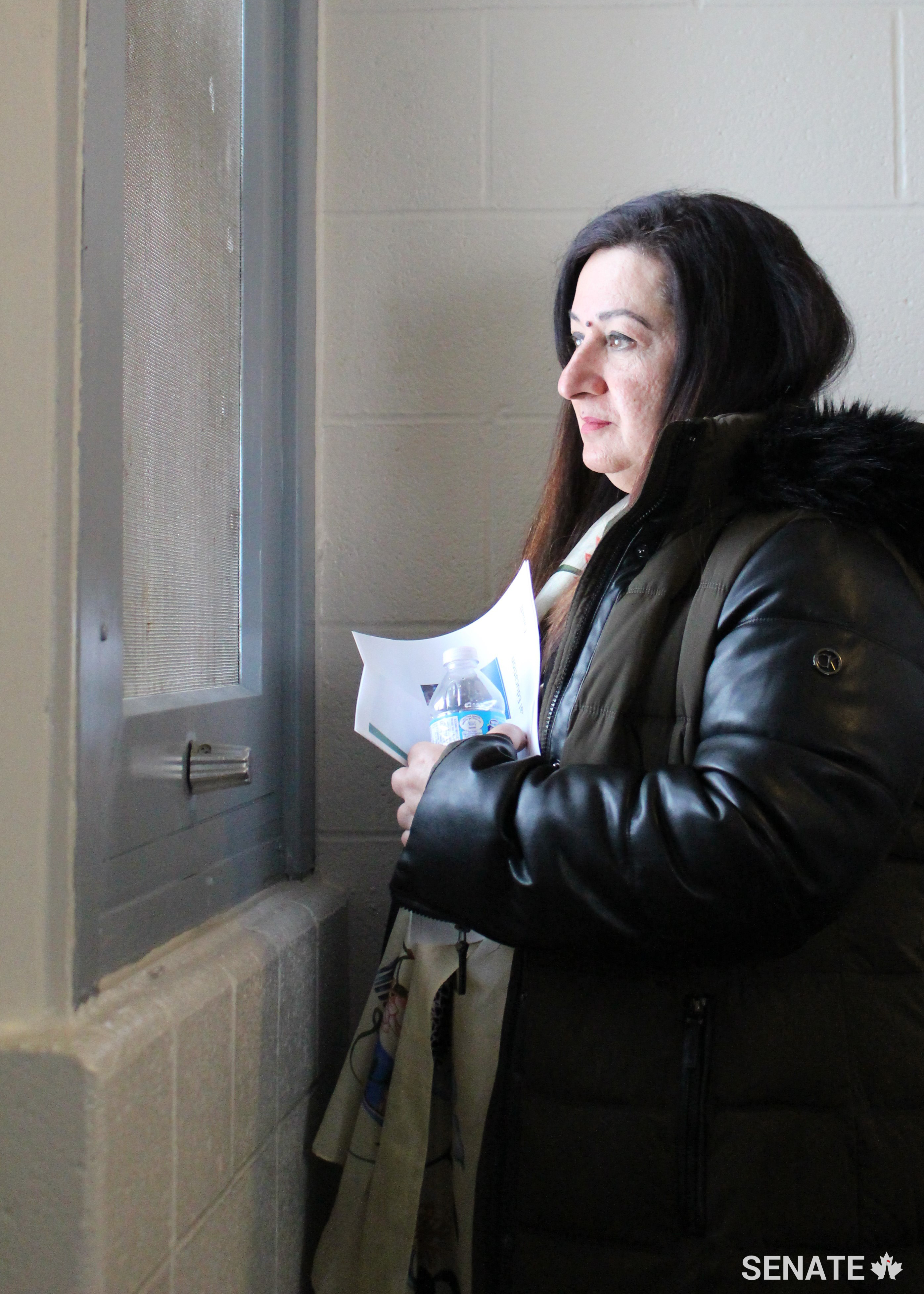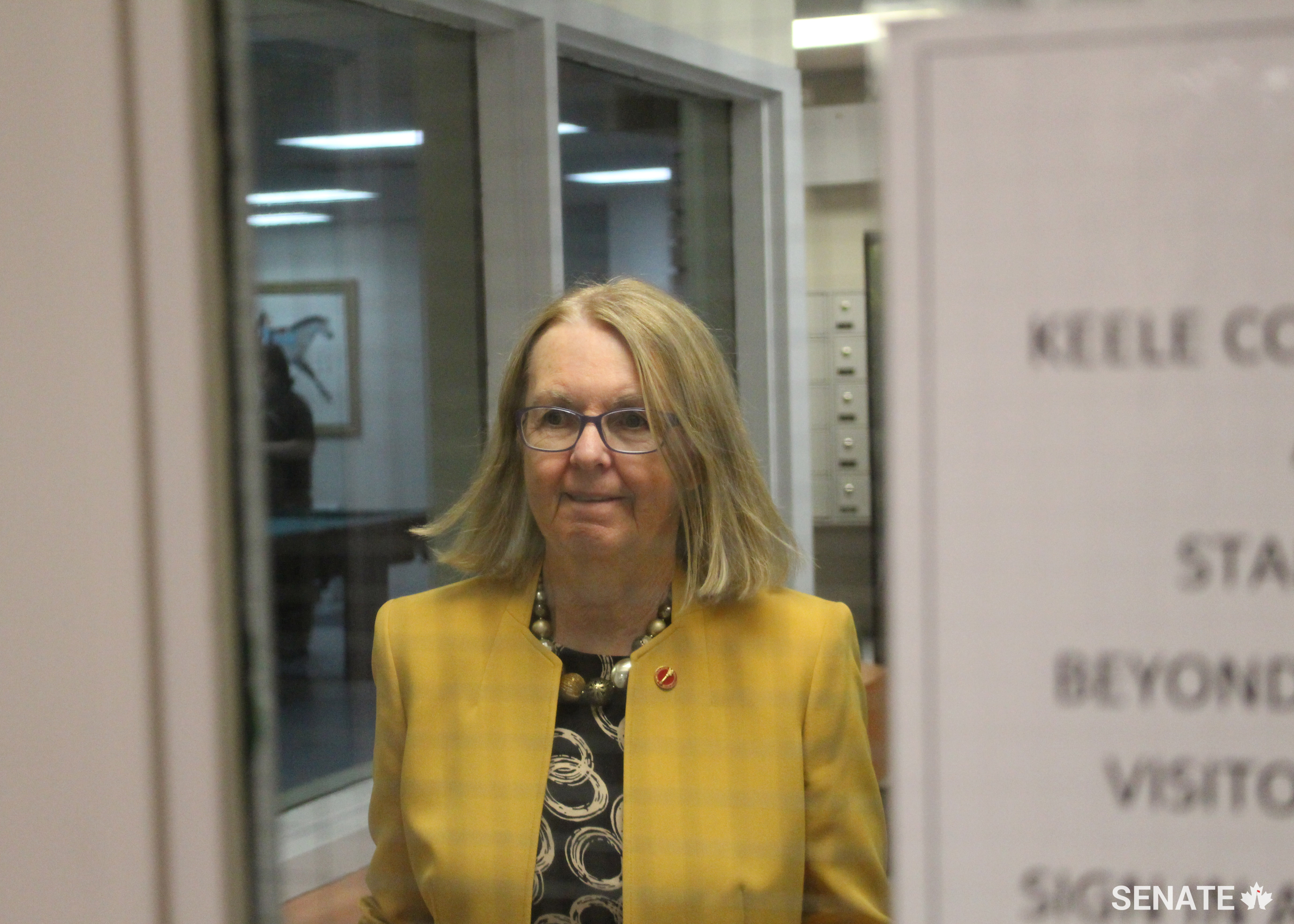Segregation takes a grim toll on prisoners

KITCHENER, Ont. — Grey light played on the tiled floor of the segregation unit at the Grand Valley Institution for Women on Friday, February 9, 2018.
There were no women in the cramped cells that day, just a red ant trap — the only splash of vivid colour — lying under the door to the suicide watch cell.
Members of the Senate Committee on Human Rights inspected the range during a fact-finding mission to the Grand Valley women’s prison in Kitchener, Ont. and to the Keele Community Correctional Centre in Toronto.
The mission formed part of the committee’s study on the human rights of prisoners — a study that has already taken them inside some of the country’s most infamous prisons.
The segregation and maximum security units at Grand Valley have their own bleak history.

The door to the first cell on the segregation range has two glass panels. The cell is for prisoners who are classified as being on suicide watch or what is known as mental health observation.
It was there, on October 19, 2007, that Ashley Smith died despite having been placed on constant observation — a 24-hour suicide watch.
She had tied a ligature around her neck but an inquest ruled her death a homicide; officers had failed to enter her cell to remove the ligature because they had been directed by management not to enter the cell unless she wasn’t breathing.
She did not believe she would die because she had thought that the officers had a duty to save her but, as Howard Sapers found in his inquiry into her death, “video evidence establishes that correctional staff failed to respond immediately to this medical emergency.”
“I believe strongly that a thorough external review of Ms. Smith’s segregation status could very likely have generated viable alternatives to her continued and deleterious placement on such a highly restrictive form of confinement,” he wrote.
Placement in segregation, even briefly, can be severely damaging to prisoners’ mental health. Enforced solitude with minimal human interaction — they are fed through meal slots in the door, for instance — virtually assures that prisoners leave the range in a far worse state than when they entered.
Nor is isolation restricted to the segregation range — senators met with women classified as maximum security prisoners who are also segregated in cells on small units and kept apart from the rest of the prison.



In a comprehensive January 2018 decision striking down sections of the Corrections and Conditional Release Act governing segregation, British Columbia Supreme Court Justice Peter Leask wrote that segregation “is a form of solitary confinement that places all Canadian federal inmates … at serious risk of psychological harm.”
“[M]any inmates are likely to suffer permanent harm as a result of their confinement,” he wrote. “This harm is most commonly manifested by a continued intolerance of social interaction, which has repercussions for inmates’ ability to successfully readjust to the social environment of the prison general population and to the broader community upon release from prison.”
Witnesses at a public hearing in Kitchener emphasized that reintegration of prisoners should be a priority for corrections staff because the overwhelming majority will find themselves back in the community.
Segregation is just one barrier to reintegration.
The committee heard evidence that Grand Valley prisoners granted temporary absence passes are routinely strip searched whenever they return from the outside world, unless they had been accompanied by Correctional Service of Canada staff.
For women who have suffered sexual abuse, strip searches can be particularly traumatizing. A witness told senators that, at a minimum, 68% of female prisoners have been sexually abused.
One woman serving time at Grand Valley said she refuses to leave the prison when she is menstruating because it is too humiliating to have to remove her tampon in front of the guards.
Committee chair Senator Wanda Thomas Bernard, deputy chair Senator Salma Ataullahjan, deputy chair Senator Jane Cordy and Senator Kim Pate took part in the fact-finding mission.
The study continues.


Related articles
Tags
Committee news
Segregation takes a grim toll on prisoners

KITCHENER, Ont. — Grey light played on the tiled floor of the segregation unit at the Grand Valley Institution for Women on Friday, February 9, 2018.
There were no women in the cramped cells that day, just a red ant trap — the only splash of vivid colour — lying under the door to the suicide watch cell.
Members of the Senate Committee on Human Rights inspected the range during a fact-finding mission to the Grand Valley women’s prison in Kitchener, Ont. and to the Keele Community Correctional Centre in Toronto.
The mission formed part of the committee’s study on the human rights of prisoners — a study that has already taken them inside some of the country’s most infamous prisons.
The segregation and maximum security units at Grand Valley have their own bleak history.

The door to the first cell on the segregation range has two glass panels. The cell is for prisoners who are classified as being on suicide watch or what is known as mental health observation.
It was there, on October 19, 2007, that Ashley Smith died despite having been placed on constant observation — a 24-hour suicide watch.
She had tied a ligature around her neck but an inquest ruled her death a homicide; officers had failed to enter her cell to remove the ligature because they had been directed by management not to enter the cell unless she wasn’t breathing.
She did not believe she would die because she had thought that the officers had a duty to save her but, as Howard Sapers found in his inquiry into her death, “video evidence establishes that correctional staff failed to respond immediately to this medical emergency.”
“I believe strongly that a thorough external review of Ms. Smith’s segregation status could very likely have generated viable alternatives to her continued and deleterious placement on such a highly restrictive form of confinement,” he wrote.
Placement in segregation, even briefly, can be severely damaging to prisoners’ mental health. Enforced solitude with minimal human interaction — they are fed through meal slots in the door, for instance — virtually assures that prisoners leave the range in a far worse state than when they entered.
Nor is isolation restricted to the segregation range — senators met with women classified as maximum security prisoners who are also segregated in cells on small units and kept apart from the rest of the prison.



In a comprehensive January 2018 decision striking down sections of the Corrections and Conditional Release Act governing segregation, British Columbia Supreme Court Justice Peter Leask wrote that segregation “is a form of solitary confinement that places all Canadian federal inmates … at serious risk of psychological harm.”
“[M]any inmates are likely to suffer permanent harm as a result of their confinement,” he wrote. “This harm is most commonly manifested by a continued intolerance of social interaction, which has repercussions for inmates’ ability to successfully readjust to the social environment of the prison general population and to the broader community upon release from prison.”
Witnesses at a public hearing in Kitchener emphasized that reintegration of prisoners should be a priority for corrections staff because the overwhelming majority will find themselves back in the community.
Segregation is just one barrier to reintegration.
The committee heard evidence that Grand Valley prisoners granted temporary absence passes are routinely strip searched whenever they return from the outside world, unless they had been accompanied by Correctional Service of Canada staff.
For women who have suffered sexual abuse, strip searches can be particularly traumatizing. A witness told senators that, at a minimum, 68% of female prisoners have been sexually abused.
One woman serving time at Grand Valley said she refuses to leave the prison when she is menstruating because it is too humiliating to have to remove her tampon in front of the guards.
Committee chair Senator Wanda Thomas Bernard, deputy chair Senator Salma Ataullahjan, deputy chair Senator Jane Cordy and Senator Kim Pate took part in the fact-finding mission.
The study continues.




